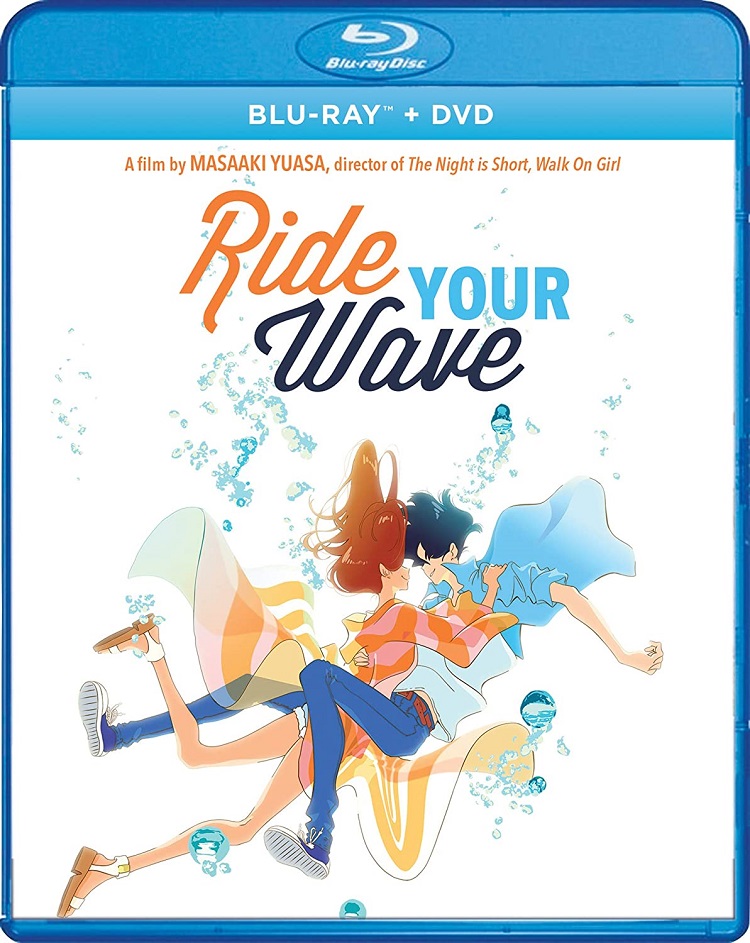
For the first half hour of Ride Your Wave, it seems like Masaaki Yuasa was tackling something he’d only ever flirted with in his previous animated offerings: realism. Without once abandoning the exaggerated squish and stretch sense of movement that is his primary visual signature, Ride Your Wave begins primarily being about real people, in real situations, without the hyperbole, magical realism or out and out crazy that’s the hallmark of Yuasa’s films. The majority of the film is not spent in the belly of the whale, like Mind Game, or hanging out with mythical fish monsters like Lu Over the Wall.
It’s about a boy, who likes a girl. He knows her, and she doesn’t know him, but they meet when he rescues her from a burning building (he’s a firefighter) and she decides to teach him to surf. That’s what she knows how to do. It’s all she knows how to do, because otherwise she’s kind of a mess. She, Hinako, is maybe the heir to some family fortune but she’s struck out on her own to… surf… and that’s about it. Minato, he, is a firefighter who believes very strongly in helping other people. And he wants to help out Hinako. Not in a knight in shining armor way, but more like a strong support. He wants her to learn to “ride her own wave”.
But he also wants to impress her with his surfing, which he is terrible at, so he goes out on his own. There’s an accident with some jetskiers, and perpetual hero Minato goes out to sea to save a drowning man. He doesn’t come back.
Hinako is shattered. She’s lived her live glibly, easily, and now she finds nothing to be glib or easy about. She’s even moved, just so she can get away from the sea and away from surfing, the one thing that was her own. Now she has nothing… until she sings a song that she and Minato used to sing together, some old stupid pop tune. And when she does, she sees Minato in her glass of water, giving her a surfer’s shaka-sign with his hand. Hanging loose in her beverage.
This is where the movie breaks loose with its rather strict realism, and where it might break out of the field of interest for a sizable chunk of its audience. The romance between Minato and Hinako was sweet and touching. Masaaki Yuasa’s films are usually devoid of typical anime cliché, and this romance was no exception: it was straightforward, un-contrived, and felt real. The sharp left turn into spirits appearing in water breaks that, a little… and then Hinako’s obsessions goes further. It gets to the point where she’s dancing around town with a water-filled balloon shaped like a finless porpoise (a favorite animal of the couple) like some anime remake of Lars and the Real Girl. It’s a diametrical break with the story and tone of the first part of the film. It asks a lot of an audience to keep their emotions involved, and I wouldn’t be surprised if a healthy number of potential fans tapped out at this development.
It ends up working, in the main, and that’s because the characters all have their cores of reality. Minato’s buddy Wasabi is an anchor for the audience, and Minato’s acerbic sister Yoko is constantly trying to torpedo Hinako’s self-indulgent spirals into essentially worshiping the memory of her dead lover… none of which stops Ride Your Wave from being a lopsided, strange film that veers from realistic romance into essentially a ghost story.
The film is buoyed by the Masaaki Yuasa style. While there isn’t the wildly exaggerated surrealism of some of his previous films, Ride Your Wave does engage in techniques that a surprisingly few anime films do: actual filmmaking. There’s a charming sequence of Hinako finding her way home on a bicycle that looks like it is shot by a wide-angle, fish-eye lens. There’s a wind-surfing sequence where the camera engages in wild movements, from surfers to a nearby boat in movements that would be impossible for a real camera to capture. It’s an energetic sequence that demonstrates not only the growing engagement of the two young loves but also the excitement of their athletic pursuits, without being particularly showy. It’s just a proper use of the main advantage of animation: do that which real-life camerawork cannot.
Compared to most other anime filmmakers, Yuasa’s animation is more plastic. It doesn’t feel as rigid or hidebound by convention. This has twin effects: it looks sloppy and simplistic as hell, and the sloppiness has an energy that most other anime films can lack.
Ride Your Wave is a tragic love story, and a weird ghost story. The two parts do not feel alien to each other, but they also do not live easily beside each other. As a Masaaki Yuasa film, they feel a little like a beast has been uneasily tamed. His previous features have had far wilder flights of fancy. They also have been more alienating, and required more patience. For me, it took some deliberate patience to cohere the halves of Ride Your Wave‘s narrative: the tragic love story and the weird ghost antics. It’s an odd story, but also oddly engaging. It was never dull, nor slow, just odd.
Ride Your Wave has been released on Blu-ray, DVD and digital by GKids, with both the original Japanese with English subtitles and an English dub. Extras include an interview with the producer Eunyoung Choi (9 mins) and animated storyboards.